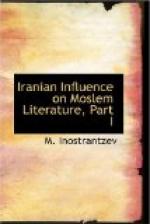P. 163, The story of Balash as narrated by Kisrawi,
(on this story Baron
Rosen bases his investigation of the Pahlavi Khodaynama.)
P. 168, An anecdote of King Aberwez.
Professor Inostranzev finds the following Iranian
material in the
Mahasin-wal masavi and the Mahasin-wal azdad (MM=Mahasin-wal
Masavi, and
MA=Mahasin wal-azdad):
MA, 21, 4 to 10—MM, 490, 2 to 7.
MA, 37, 12 to 14—MM, 128, 11 to 12.
MA, 53, 14 to 16—MM, 571, 1 to 3.
MA, 78, 5 to 9—MM, 202, 2 to 5.
MA, 79, 2 to 6—MM, 202, 14 to 16.
MA, 79, 6 to 11—MM, 202, 16 to 203, 2.
MA, 168,20 to 3—MM, 310, 16 to 18.
MA, 170, 2 to 3—MM, 313, 7 to 8.
MA, 173, 8 to 16—MM, 372, 11 to 18.
In connection with the importance of Kisrawi as regards the Persian literary material, these are the extracts from him in the two Arabic works:
MA, 168, 20 to 269, 3—MM, 310, 16 to 18.
MA, 53, 14 to 16—MM, 571, 1 to 3.
MA, 359, 13 to 364, 6—MM, 376, 1 to 9.
In view of the remarks by Browne (Literary History,471 to 475) regarding the significance of Persian words and expressions in the ancient Arabic literary works for the history of the Persian language, of particular importance are the excerpts from Kisrawi, MA 168,20 to 269, 3—MM, 310, 16 to 18, where occur Persian phrases from the maxims of Anushirwan “which as I think have been handed down to us in pure Pahlavi.” Interesting is the interpretation of the Persian word Mihman at another place in the same Arabic books, viz:—MA, 79, 6 to 11=MM, 202, 16 to 203, 2.
APPENDIX III
[Translation of Noeldeke’s Burzoe’s Einleitung zu dem Buche Kalila wa Dimna.]
BURZOE’S INTRODUCTION TO THE BOOK OF KALILA WA DIMNA.
[Sidenote: Burzoe’s Introduction not fabricated.]
The Arabic redaction of the Indian tales which we know under the name of Kalila wa Dimna had two unquestionably genuine Introductions, that of the compilator Ibn Moqaffa himself who died in 142 A.H., and that of Burzoe who in the time of King Khusrow I, (A.D. 531 to 579) brought the book from India and translated it into the written Persian language of the time, the Pehlevi. The circumstances regarding the mission of Burzoe to India are still not clear. At any rate Ibn Moqaffa did not write as we read them now.
Nevertheless it is by no means improbable that he had affixed to his book a report which, however, wan subsequently mutilated, of necessity, in diverse ways. The preface by Ala-ibn-Shah or Behbod, which has also been printed by de Sacy, which is found in a few manuscripts and which is not known to the ancient translations is a later and entirely valueless excrescence.
The Introduction of Burzoe stood in the Pehlevi work which Ibn Moqaffa had before him. According to certain manuscripts this Introduction has been compiled—or however we translate the ambiguous term tarjuma—by Burzgmihir, the prime minister of Khusrow, much better known in polite literature than in history.




